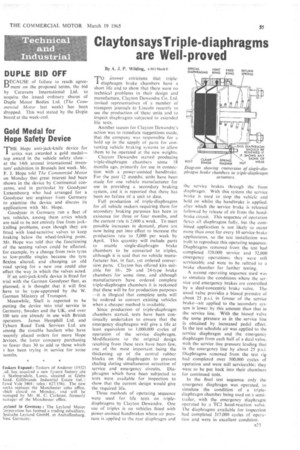Clayton saysTriple-diaphragms are Well-proved
Page 57

If you've noticed an error in this article please click here to report it so we can fix it.
By A. J. P. Wilding, A 1 Meek E TO swer criticisms that triplediaphragm brake chambers have a short life and to show that there were no technical problems in their design and manufacture, Clayton Dewandre Co. Ltd. invited representatives of a number of transport journals to Lincoln recently to see the production of these units and to inspect diaphragms subjected to extended life tests.
Another reason for Clayton Dewandre's action was to repudiate suggestions made, that the company was responsible for a hold up in the supply of parts for converting vehicle braking s).stems to allow them to be operated at the new weights.
Clayton Dewandre started producing triple-diaphragm chambers some 18 months ago, primarily for use in connection with a power-assisted handbrake. For the past 12 months, units have been made for one vehicle manufacturer for use in providing a secondary braking system, and it is reported that there has been no failure of a unit to date.
Full production of triple-diaphragms for all vehicle makers requiring them for secondary braking purposes has been in existence for three or four months, and the current rate is 2,000 a week. To meet possible increases in demand, plans are now being put into effect to increase the production rate to 5,000 per week by April. This quantity will include parts to enable single-diaphragm brake chambers to be converted to triples, although it is said that no vehicle manufacturer has, in fact. yet ordered conversion parts. Clayton has offered kits suitable for 16-, 20and 24-type brake chambers for some time, and although manufacturers have ordered complete triple-diaphragm chambers it is reckoned that these will be for production purposes —it is illogical that complete units will be ordered to convert existing vehicles when a cheaper method is available,
Since production of triple-diaphragm chambers started, tests have been continually undertaken to ensure that the emergency diaphragms will give a life at least equivalent to 1.000,000 cycles of operation of the service diaphragm. Modifications to the original design resulting from these tests have been few, one of the most important being the thickening up of the central rubber blocks on the diaphragms to prevent chafing during simultaneous actuation of service and emergency circuits. Diaphragms which have been subjected to tests were available for inspection to show that the current design would give the required life.
Three methods of operating sequence were used for life tests on triplediaphragms by Clayton Dewandre. One use of triples is on vehicles fitted with power-assisted handbrakes where air pressure is applied to the rear diaphragm and
the service brakes through the front diaphragm. With this system the service brake is used to stop the vehicle and held on whilst the handbrake is applied. after which the service brake is released followed by release of air from the handbrake circuit. This sequence of operation flexes all diaphragms fully, but the combined application is not likely to occur more than once for every 10 service-brake applications, so the test installation was built to reproduce this operating sequence. Diaphragms removed from the test had completed 320,000 service • and 32,000 emergency operations; they were still serviceable and were to be refitted to a brake chamber for further testing.
A second operating sequence used was to simulate the conditions where the service and emergency brakes are controlled by a dual-concentric brake valve. The usual valve provides a biased pressdre of about 25 p.s.i. in favour of the service brake—air applied to the secondary system is lower by this amount than that in the service line. With the biased valve the same pressure as in the service line is obtained by increased pedal effort. In the test schedule air was applied to the service diaphragm and the emergency diaphragm from each half of a dual valve, with the service line pressure leading that in the emergency line by about 25 psi. Diaphragms removed from the test rig had completed over 500,000 cycles of operation and were still serviceable; they were to be put back into their chambers for continued tests.
In the final test sequence only the emergency diaphragm was operated, to simulate the condition of a triplediaphragm chamber being used on a semitrailer, with the emergency diaphragm Operated by a TC2 hand-reaction valve. The diaphragms available for inspection had completed 317,000 cycles of operation and were in excellent condition.












































































































































